EP203 AUTOMATIC EXTINGUISHER PANEL
Approved Document No. DFU0002032 Rev 4 • EP203 AUTOMATIC EXTINGUISHER PANEL INSTALLATION MANUAL • Page 35 of 45
FAULT DIAGNOSIS
Overview
When a fault occurs on the system, the EP203 panel responds by activating its internal
sounder, the General Fault yellow LED flashes, any other specific yellow Fault LEDs flash
and the LCD unit displays the specific fault.
The EP203 panel’s fault output will also activate (provided it has NOT been disabled).
Fixing any particular fault condition will automatically clear the fault from the EP203
panel. If the EP203 panel is reset whilst faults still exist, the faults will reappear after a
short duration.
Note: It is possible to mute the EP203 panel’s internal sounder at any time by
momentarily pressing the Silence Internal Sounder pushbutton.
Detection Zone Faults
The three detection zone circuits are monitored for open and short-circuit faults (unless
there is an alarm condition, or the zone is in test, or disabled). The following lists typical
fault diagnosis for zone faults:
O pen-ci rcuit , o r sho rt-ci rcui t faul t has occur red on a detecti on z one
An open, or short-circuit fault on a detection zone is indicated by the following:
• Internal panel sounder activates
• General Fault yellow LED flashes
• Specific Zone Fault yellow LED flashes
• LCD unit displays the specific fault (e.g. Zone 1 O/C fault, Zone 2 S/C fault).
Suggested action:
1. Disconnect the faulty detection zone completely from the Main Control PCB and
refit a 6k8 ohm end-of-line resistor at the panel terminals. If the fault condition
clears this confirms there is a wiring fault.
2. Double-check and refit the circuit wiring and the end-of-line resistor. Trace the
fault with consideration to the type of fault indicated at the panel and on the
LCD unit.
Note: A common short circuit fault is a detector head badly seated in a base that is not
making a true connection.

